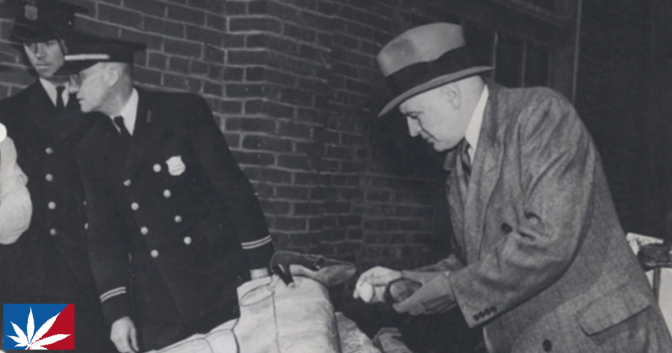80 Years of Reefer Madness (Part 1): 1937-1970

Eighty years ago, on August 2, 1937, President Franklin D. Roosevelt signed House Bill 6385, the Marihuana Tax Act, into law. It took effect that October. The law, for the first time, imposed federal criminal penalties on activities specific to the possession, production and sale of cannabis, ushering in the modern era of federal prohibition.
Congress’ decision followed the 29 states that had previously passed laws criminalizing marijuana, beginning with Massachusetts in 1914. It also followed years of Reefer Madness, during which time politicians, bureaucrats (led primarily by Federal Bureau of Narcotics director Harry Anslinger), reporters and science editors continually proclaimed that marijuana use irreparably damaged the brain. A 1933 editorial in the Journal of Criminal Law and Criminology largely summarized the sentiment at the time: “If continued, the inevitable result is insanity, which those familiar with it describe as absolutely incurable, and, without exception ending in death.”
Rep. Robert L. Doughton of North Carolina introduced the Marihuana Tax Act on April 14, 1937. It promised to stamp out the recreational use of marijuana by imposing a prohibitive federal tax—$100 an ounce, at a time when a 25 cent-an-hour federal minimum wage was still a year away—on all cannabis-related activities. Members of Congress quickly rallied around it, a dramatic departure from years earlier, when lawmakers had promptly rejected similar efforts.
Congress held only two hearings to debate the merits of the bill. They largely relied on the sensationalist testimony of Anslinger, who asserted before the House Ways and Means Committee, “This drug is entirely the monster Hyde, the harmful effect of which cannot be measured.” He was countered by the American Medical Association’s legislative counsel, Dr. William C. Woodward, who argued that there was no hard evidence to support Anslinger’s hyperbolic claims.
“We are told that the use of marijuana causes crime,” Dr. Woodward testified. “But yet no one has been produced from the Bureau of Prisons to show the number of prisoners who have been found addicted to the marijuana habit… You have been told that schoolchildren are great users of marijuana cigarettes. No one has been summoned from the Children’s Bureau to show the nature and extent of the habit among children. Inquiry of the Children’s Bureau shows that they have had no occasion to investigate it, and know nothing particularly of it.” He further contended that the bill would severely hamper physicians’ ability to prescribe cannabis as a medicine.
Woodward’s objections fell upon deaf ears. The Ways and Means Committee quickly sent the measure to the House floor, which promptly forwarded it to the Senate. Senators moved it on the basis of a single hearing, one that was again dominated by Anslinger’s fear-mongering rhetoric. The House and Senate reconciled their versions by midsummer. Just five months after its introduction, President Roosevelt signed the Marihuana Tax Act into law.
On Oct. 2, 1937, the first arrests were made when Samuel Caldwell, 58, and Moses Baca, 26, were pinched in Denver, Caldwell for sales and Baca for buying joints from him. Both did time for their transgressions; Caldwell, considered the first cannabis convict, spent four years at the Leavenworth federal penitentiary in Kansas.
The law’s ramifications became apparent over the ensuing decades. Physicians ceased prescribing cannabis as a therapeutic remedy, and in 1942, it was removed from the U.S. pharmacopeia. American hemp cultivation also ceased, although it got a short-lived reprieve during World War II. Law enforcement began routinely arresting marijuana consumers and sellers.
Despite prohibition, marijuana only grew in popularity. By the late 1960s, some eight to 12 million Americans were estimated to be cannabis consumers. As its use continued to grow, pressure mounted on lawmakers to reconsider federal marijuana policy. In 1969, the Supreme Court struck down the Tax Act as unconstitutional, in the Leary v. United States case. The justices unanimously ruled that LSD advocate Timothy Leary could not have paid the pot tax without exposing himself to prosecution under state laws, violating his Fifth Amendment right to be free from self-incrimination.
With the Marihuana Tax Act void, members of Congress formulated a new approach. In 1970, the Controlled Substances Act categorized marijuana as a Schedule I prohibited substance, defining it as a drug of abuse with no medical benefits. But there was a caveat: The classification was only intended to be temporary. The new law called for the creation of a special federal commission to study all aspects of the cannabis plant, including its use and users. Once and for all, Congress was going to determine whether there was any truth to the claims that marijuana was a dangerous drug that deserved strict criminal prohibition.
After nearly two years of scientific research and millions of dollars spent, the National Commission on Marihuana and Drug Abuse completed its investigation and issued its report to Congress and to President Richard Nixon on March 22, 1972, trumpeting it as “the most comprehensive study of marihuana ever made in the United States.” In unambiguous language, it rebutted virtually every negative claim made about marijuana’s alleged dangers. The Commission concluded that it was not a so-called “gateway drug” to hard drugs like heroin, that its use was not associated with violence or aggressive activity, and that its consumption was not physiologically or psychologically detrimental to users’ health.
“Neither the marihuana user nor the drug itself can be said to constitute a danger to public safety,” the researchers concluded. “Therefore, the Commission recommends… [the] possession of marijuana for personal use no longer be an offense, [and that the] casual distribution of small amounts of marihuana for no remuneration, or insignificant remuneration no longer be an offense.”
The Commission’s findings and recommendations should have triggered a serious review of federal marijuana policy and penalties. That didn’t happen. Instead, Nixon vehemently rejected the report’s conclusions, and the federal government doubled down on its efforts to demonize the herb. As had been the case more than three decades earlier, science and reason held little sway with federal policymakers, who instead chose to embrace cultural and racial stereotypes over facts and evidence.
Flexing the muscle of the newly formed super-agency, the Drug Enforcement Administration, Nixon declared that his administration was launching the first official “War on Drugs.” Public Enemy No. 1 in this battle was weed. That federal war continues, largely unabated, today.
If you enjoyed this Freedom Leaf article, subscribe to the magazine today!

